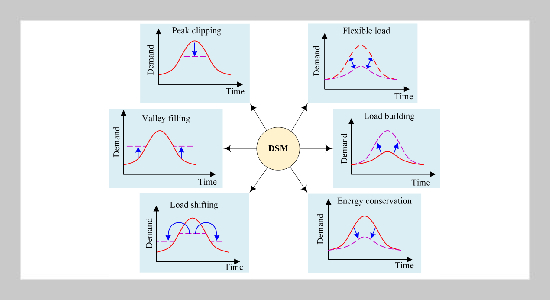- [1] B. Dey, F. P. G. Márquez, and A. Bhattacharya, (2022) “Demand side management as a mandatory inclusion for economic operation of rural and residential microgrid sys�tems" Sustainable Energy Technologies and Assess�ments 54: 102903.
- [2] A. T. Dahiru, D. Daud, C. W. Tan, Z. T. Jagun, S. Sam�sudin, and A. M. Dobi, (2023) “A comprehensive review of demand side management in distributed grids based on real estate perspectives" Environmental Science and Pollution Research: 1–30.
- [3] B. Koul, K. Singh, and Y. Brar, (2021) “An introduction to smart grid and demand-side management with its in�tegration with renewable energy" Advances in Smart Grid Power System: 73–101.
- [4] P. Kumar, I. Ali, and D. V. Thanki. “Demand-side management: Energy efficiency and demand re�sponse”. In: Handbook of Research on Power and Energy System Optimization. IGI Global, 2018, 453–479.
- [5] P. Gupta. Demand Side Management: An approach to peak load smoothing. 2012.
- [6] K. Gyanwali and T. R. Bajracharya. “Demand side management in industrial sector of nepal”. In: Pro�ceedings of IOE Graduate Conference. 1. 2013, 108–116.
- [7] A. Glazunova, (2022) “Development of a Day-Ahead Demand Side Management Strategy to Improve the Mi�crogrid Efficiency" IFAC-PapersOnLine 55(9): 256–261.
- [8] M. Izadi, F. Razavi, et al., (2017) “Energy Loss Re�duction in a 20-kV Distribution Network Considering Available Budget" Journal of Applied Science and Engineering 20(1): 21–30.
- [9] C. Tao, Q. Zhuo, X. Guo, W. Wang, T. Li, and X. Bai, (2023) “Research On Voltage Coordinated Control Of Active Distribution Network Considering Demand Re�sponse" Journal of Applied Science and Engineering 26(8): 1083–1094.
- [10] S. N. Bragagnolo, J. C. Vaschetti, and F. Magnago, (2021) “A technical and economic criteria comparison on demand side management with multi-level optimization model" IEEE Latin America Transactions 19(9): 1494–1501.
- [11] R. Torkan, A. Ilinca, and M. Ghorbanzadeh, (2022) “A genetic algorithm optimization approach for smart energy management of microgrids" Renewable Energy 197: 852–863.
- [12] M. Awais, N. Javaid, N. Shaheen, Z. Iqbal, G. Rehman, K. Muhammad, and I. Ahmad. “An efficient genetic algorithm based demand side management scheme for smart grid”. In: 2015 18th international conference on network-based information systems. IEEE. 2015, 351–356.
- [13] L. Mellouk, M. Boulmalf, A. Aaroud, K. Zine-Dine, and D. Benhaddou, (2018) “Genetic algorithm to solve demand side management and economic dispatch prob�lem" Procedia computer science 130: 611–618.
- [14] R. H. Saloom and H. K. Khafaji, “A New Technique for Genetic Mutations Detection and Classification Using Deep Learning":
- [15] Z. Garroussi, R. Ellaia, E.-G. Talbi, and J.-Y. Lucas, (2020) “A hybrid non-dominated sorting genetic algo�rithm for a multi-objective demand-side management prob�lem in a smart building" International Journal of Elec�trical & Computer Engineering (2088-8708) 10(1):
- [16] Y. Barradi, N. Khaldi, K. Zazi, and M. Zazi, (2019) “A novel genetic approach applied for power loss reduction and improved bus voltage profile in distribution network system" International Journal of Intelligent Engi�neering and Systems 12(6): 91–99.
- [17] J. Pono´cko. Data analytics-based demand profiling and advanced demand side management for flexible operation of sustainable power networks. Springer Nature, 2020.
- [18] B. Mota, P. Faria, and Z. Vale, (2022) “Residential load shifting in demand response events for bill reduction using a genetic algorithm" Energy 260: 124978.
- [19] D. Javor and A. Janjic, (2016) “Application of demand side management techniques in successive optimization procedures" Communications in Dependability and quality management 19(4): 40–51.
- [20] M. Gunasekaran, H. Mohamed Ismail, B. Chokkalingam, L. Mihet-Popa, and S. Padmana�ban, (2018) “Energy management strategy for rural communities’ DC micro grid power system structure with maximum penetration of renewable energy sources" Applied Sciences 8(4): 585.
- [21] A. Tavakoli, S. Saha, M. T. Arif, M. E. Haque, N. Mendis, and A. M. Oo, (2020) “Impacts of grid inte�gration of solar PV and electric vehicle on grid stability, power quality and energy economics: A review" IET En�ergy Systems Integration 2(3): 243–260.
- [22] S. Ponrekha A, M. Subathra, C. Bharatiraja, N. Manoj Kumar, and H. Haes Alhelou, (2022) “A topology re�view and comparative analysis on transformerless grid�connected photovoltaic inverters and leakage current re�duction techniques" IET Renewable Power Genera�tion:
- [23] K. Parvin, M. Hannan, L. H. Mun, M. H. Lipu, M. G. Abdolrasol, P. J. Ker, K. M. Muttaqi, and Z. Dong, (2022) “The future energy internet for utility energy ser�vice and demand-side management in smart grid: Current practices, challenges and future directions" Sustainable Energy Technologies and Assessments 53: 102648.
- [24] F. Rabee, I. Jazaery, and K. Kumar, (2023) “Quaternary�Child Crossover for Genetic Algorithm in Real-Time Scheduling Optimization" International Journal of In�telligent Engineering & Systems 16(2):
- [25] G. Strbac, (2008) “Demand side management: Benefits and challenges" Energy policy 36(12): 4419–4426.
- [26] L. A. Alnabi, A. K. Dhaher, and M. B. Essa, (2022) “Optimal Allocation of Distributed Generation with Re�configuration by Genetic Algorithm Using Both Newton Raphson and Gauss Seidel Methods for Power Losses Min�imizing" International Journal of Intelligent Engi�neering & Systems 15(1):
- [27] M. U. Saleem, M. R. Usman, M. A. Usman, and C. Politis, (2022) “Design, deployment and performance evaluation of an IoT based smart energy management system for demand side management in smart grid" IEEE Access 10: 15261–15278.
- [28] C. M. Affonso and R. V. da Silva, (2015) “Demand side management of a residential system using simulated annealing" IEEE Latin America Transactions 13(5): 1355–1360.
















